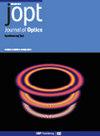优化偏振光谱信号,实现激光频率稳定
IF 2.7
4区 物理与天体物理
Q3 OPTICS
引用次数: 0
摘要
我们通过实验生成了与 87Rb 和 85Rb 的 D2 线超线性转变相对应的偏振光谱(误差)信号,并表明最强的误差信号分别对应于封闭的超线性转变(振荡器强度)和 、 、 。我们找到了两种不同光束直径下蒸汽池温度和泵探针强度的最佳值,从而使生成的误差信号不受外部参数波动的影响。我们进一步利用这些优化的误差信号来直接锁定激光频率(无需频率/相位调制)--当测量持续时间为分钟时,将均方根漂移/线宽从 MHz 降低到 kHz。此外,通过比较理论计算和实验测量的泵浦强度误差信号(其中,mW cm-2 是掺镱 D2 线跃迁的两电平饱和强度),我们讨论了现有基于全多电平速率方程模型的偏振光谱数值和分析方法的适用性和局限性。本文章由计算机程序翻译,如有差异,请以英文原文为准。
Optimization of polarization spectroscopy signal for laser-frequency stabilization
We experimentally generate polarization spectroscopy (error) signals corresponding to the D2-line hyperfine transitions, of 87Rb, and of 85Rb, and show that the strongest error signals correspond to the closed hyperfine transitions (oscillator strength ), and , respectively. We make the generated error signal robust to fluctuations in external parameters by finding optimum values for the vapor cell temperature and pump-probe intensities at two different beam diameters. We further employ these optimized error signals to directly (without the need for frequency/phase modulation) lock the laser frequency—reducing the rms drift/linewidth from MHz to kHz, when measured over a min duration. In addition, by comparing theoretically calculated and experimentally measured error signals for the pump intensities ranging from (where, mW cm−2 is the two-level saturation intensity for the Rb D2-line transitions), we discuss the applicability and limitations of existing numerical and analytical approaches based on a full multi-level rate equation model for polarization spectroscopy.
求助全文
通过发布文献求助,成功后即可免费获取论文全文。
去求助
来源期刊

Journal of Optics
OPTICS-
CiteScore
4.50
自引率
4.80%
发文量
237
审稿时长
1.9 months
期刊介绍:
Journal of Optics publishes new experimental and theoretical research across all areas of pure and applied optics, both modern and classical. Research areas are categorised as:
Nanophotonics and plasmonics
Metamaterials and structured photonic materials
Quantum photonics
Biophotonics
Light-matter interactions
Nonlinear and ultrafast optics
Propagation, diffraction and scattering
Optical communication
Integrated optics
Photovoltaics and energy harvesting
We discourage incremental advances, purely numerical simulations without any validation, or research without a strong optics advance, e.g. computer algorithms applied to optical and imaging processes, equipment designs or material fabrication.
 求助内容:
求助内容: 应助结果提醒方式:
应助结果提醒方式:


